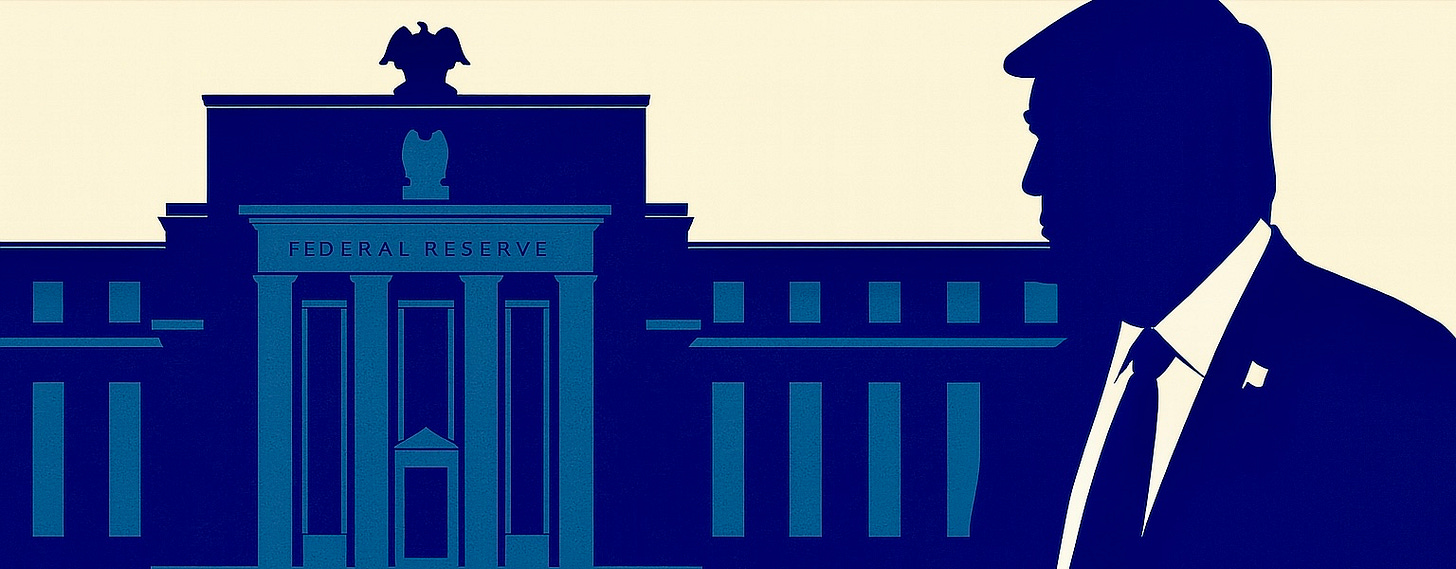Trump, Powell, and the Fed’s $3.1 Billion Monument to Failure
It’s time to rein in spending, end the Fed’s central planning, and restore honest money.
Hello Friends!
Here’s my take on President Donald Trump, Federal Reserve Chair Jerome Powell, and the excessive use of taxpayer money. Thoughts?
President Trump’s visit to the Federal Reserve wasn’t just a photo op—it was a reckoning.
While Americans face inflated grocery bills, housing unaffordability, and rising debt payments, the Fed is spending up to $3.1 billion on renovations to its D.C. headquarters. Rooftop gardens, VIP elevators, premium marble—Versailles on the Potomac.
Fed Chair Jerome Powell brushed off criticism beside Trump at the site, hard hat in hand. But no cosmetic tour can cover up what’s really wrong with the Fed: it’s fueling booms and busts, distorting production, and losing public trust.
The Fed’s $6.7 trillion bloated balance sheet, inflated through years of easy money and deficit monetization, is not just a number. It’s a weapon of central planning that misallocates capital, rewards speculation, and punishes saving. The costs aren’t always visible in CPI inflation—but they show up in falling productivity, unaffordable housing, fragile banks, and a growing sense that the economic game is rigged.
Now, add a luxury construction project that’s at least $700 million over budget and may rise to $3.1 billion, according to President Trump. The Fed’s defense? Preservation, asbestos, and historical charm.
But insiders like Russ Vought, OMB director, point to rooftop terrace gardens, VIP dining rooms, water features, and elite finishes. At $1,923 per square foot, this is less renovation than self-congratulation.
And the claim that the Fed is “self-funded” is disingenuous. It earns interest on trillions in Treasuries and mortgage-backed securities—purchased with money it prints—and collects fees from banks that ultimately get passed to customers. That’s a taxpayer burden in disguise.
Meanwhile, the Fed has racked up more than $200 billion in operating losses—the first sustained losses in its 110-year history. And yet it keeps expanding its footprint, not just with buildings, but with regulation.
Under Powell, the Fed has veered far beyond interest rates into climate policy, capital rules under Basel III, and pressure on community banks that disproportionately hurts local economies.
This isn’t technocratic oversight—it’s ideological mission creep. And the Fed’s internal politics tell the story.
In 2024, 92% of campaign donations from Fed employees went to Democrats. Since 2016, employees have donated nearly $3 million to Democrats and just $243,000 to Republicans. This is not a neutral institution. It’s a partisan power center for democrats.
All of this distortion—on rates, regulation, and spending—feeds back into the broader problem: government is too big, too costly, and too intrusive.
We don’t need lower interest rates while inflation is still running above the Fed’s own flexible 2% average target. The problem isn’t that Powell won’t cut—it’s that Congress refuses to cut spending. Interest on the national debt topped $1.1 trillion last year, not because of tight monetary policy, but because Washington spends like there’s no tomorrow.
If the U.S. wants sustainable growth, we need to stop using the Fed to mask the real problem: fiscal irresponsibility.
So what should be done?
First, Congress must conduct a full external audit of the Federal Reserve—not a surface review, but a deep dive into its balance sheet, regulatory reach, and political activity. It’s long overdue.
Second, the Fed’s balance sheet should be shrunk to a more reasonable level—closer to the pre-Great Financial Crisis norm of 6% of GDP. That would mean reducing it from $6.7 trillion to under $2 trillion. Anything less leaves markets dependent on central bank distortions.
Third, policymakers must adopt a rules-based approach across the board. That means strict limits on federal spending growth, hard constraints on monetary expansion, and curbs on the regulatory state’s ability to unilaterally impose costs on Americans.
Ultimately, we must ask whether the Fed is still serving Americans—or just protecting its power. A serious debate about ending the Fed and exploring market-based alternatives, such as competitive currencies or private monetary systems, must be on the table. Until then, a strong, rules-based system is the best option for taming this unaccountable behemoth.
The Fed was created in 1913 as a lender of last resort. Today, it’s a financier of federal deficits, a regulator of everything from housing to climate, and apparently, a luxury real estate developer.
It’s time for that to end. Let’s strip away the marble, audit the books, and get Washington—starting with the Fed—out of the business of managing the economy.
Watch my interview for more:
What did the Trump-Powell meeting at the Fed tell us? I explained yesterday on NTD News.




Great job on NTD!
The Fed is a gargantuan can of worms. Maybe the Overton Window for ending it will open at some point. Has anyone laid out a framework for what would come next?
I'm familiar with some theoretical works like Hayek's competing monies, but has someone done a white paper showing how to get from here to there? Something akin to Chile ending their Social Security system?
Or do we just wait for the market to reject fiat and move to gold/btc/whatever, struggling against legal tender laws and currency controls? It would sure be nice to have an orderly transition rather than a market-forced/chaotic one.